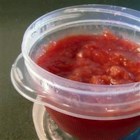Spinach is growing abundantly in our greenhouse right now. Order yours today! Following are some great recipes and see below for some health facts on spinach and strawberries.
Strawberry-Spinach Salad on a Stick

Ingredients
- 1 large container strawberries, washed, dried, & stems removed
- 1/2 cup sliced almonds
- 1 bag baby spinach leaves, washed, dried & stems removed
- wooden skewers, (see note)
Pierce one strawberry onto a skewer and slide it down leaving about 3-4 inches at the end of the stick. This will be the handle. Stack 3-4 spinach leaves, fold them over and pierce onto the stick. Alternate with the remaining berries and spinach. Lay the kebabs onto a serving platter. (can be covered with Saran Wrap and refrigerated at this point). When ready to serve, drizzle with dressing and sprinkle with almonds.
Vinaigrette
- 1/2 cup balsamic vinegar
- 1/4 cup honey
- 1/2 cup olive oil
- 1 teaspoon Dijon mustard
Whisk all ingredients together.
Strawberry spinach salad with champagne vinaigrette
Vinaigrette:
- 1/4 c Champagne vinegar
- 2 tbs agave nectar
- 1 tbsp freshly squeezed lemon juice
- 1/2 tsp Dijon mustard
- 1/4 c olive oil
- salt and pepper to taste
Salad:
- 4 c baby spinach (or spring greens)
- 1 c sliced strawberries
- 1/3 c raw sunflower seeds
- pepper to taste
Whisk vinaigrette, toss salad, and sprinkle vinaigrette over greens and strawberries.
Health benefits of Spinach
- Spinach is store house for many phyto-nutrients that have health promotional and disease prevention properties.
- Very low in calories and fats (100 g of raw leaves provide just 23 cal). It contains good amount of soluble dietary fiber; no wonder greeny spinach is one of the vegetable source recommended in cholesterol controlling and weight reduction programs!
- Fresh 100 g of spinach contains about 25% of daily intake of iron; one of the richest among green leafy vegetables. Iron is an important trace element required by the body for red blood cell production and as a co-factor for oxidation-reduction enzymes cytochrome-oxidases during the cellular metabolism.
- Fresh leaves are rich source of several vital anti-oxidant vitamins like vitamin A, vitamin C; and flavonoid poly phenolic antioxidants such as lutein, zea-xanthin and beta-carotene. Together these compounds help act as protective scavengers against oxygen-derived free radicals and reactive oxygen species (ROS) that play a healing role in aging and various disease processes.
- Zea-xanthin, an important dietary carotenoid, is selectively absorbed into the retinal macula lutea in the eyes where it is thought to provide antioxidant and protective light-filtering functions; thus helps protect from "age related macular disease" (ARMD), especially in the elderly.
- Vitamin A is also required for maintaining healthy mucus membranes and skin and is essential for vision. Consumption of natural vegetables and fruits rich in vitamin A and flavonoids helps body protect from lung and oral cavity cancers.
- 100 g of Spinach provides 402% of daily vitamin-K requirements. Vitamin K plays vital role in strengthening bone mass by promoting osteotrophic (bone building) activity in the bone. It also has established role in patients with Alzheimer's disease by limiting neuronal damage in the brain.
- This greeny leafy vegetable also contain good amounts of many B-complex vitamins like vitamin- B6(pyridoxine), thiamin (vitamin B-1), riboflavin, folates and niacin. Folates help prevent neural tube defects in the offspring.
- 100 g of farm fresh spinach has 47% of daily recommended levels of vitamin C. Vitamin C is a powerful antioxidant which helps body develop resistance against infectious agents and scavenge harmful oxygen free radicals.
- The leaves also contain good amount of minerals like potassium, manganese, magnesium, copper and zinc. Potassium in an important component of cell and body fluids that helps controlling heart rate and blood pressure. Manganese and copper are used by the body as a co-factor for the antioxidant enzyme superoxide dismutase. Copper is required in the production of red blood cells. Zinc is a co-factor in many enzymes that regulate growth and development, sperm generation, digestion and nucleic acid synthesis.
- It is also rich source of omega-3 fatty acids.
Regular consumption of spinach in the diet helps prevent osteoporosis (weakness of bones), iron deficiency anemia and is believed to protect from cardiovascular diseases and colon and prostate cancers.
Health benefits of strawberries
- Strawberry is low in calories (32 kcal/100g) and fats but rich source of many health promoting phyto-nutrients, minerals and vitamins that are essential for optimum health.
- Strawberries have significantly high amounts of phenolic flavonoid phyto-chemicals calledanthocyanins and ellagic acid. Scientific studies show that consumption of straw berries may have potential health benefits against cancer, aging, inflammation and neurological diseases.
- Fresh berries are an excellent source of vitamin-C (about 98% of RDI), which is also a powerful natural antioxidant. Consumption of fruits rich in vitamin C helps body develop resistance against infectious agents, counter inflammation and scavenge harmful free radicals.
- The fruit is rich in B-complex group of vitamins. It contains very good amounts of vitamin B-6, niacin, riboflavin, pantothenic acid and folic acid. These vitamins are acting as co-factors help body metabolize carbohydrates, proteins and fats.
- Strawberries contain vitamin A, vitamin E and many health promoting flavonoid poly phenolic antioxidants such as lutein, zeaxanthin, beta carotene in small amounts. These compounds help act as protective scavengers against oxygen-derived free radicals and reactive oxygen species (ROS) that play a role in aging and various disease process.
- They contain good amount of minerals like potassium, manganese, fluorine, copper, iron and iodine. Potassium in an important component of cell and body fluids that helps controlling heart rate and blood pressure. Manganese is used by the body as a co-factor for the antioxidant enzyme superoxide dismutase. Copper is required in the production of red blood cells. Iron is required for red blood cell formation. Fluoride is a component of bones and teeth and is important for prevention of dental cavities.









